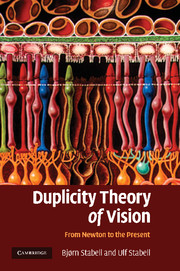Book contents
- Frontmatter
- Contents
- Acknowledgements
- 1 Introduction
- Part I The development of the basic ideas of the duplicity theory from Newton to G. E. Müller
- Part II The development of the duplicity theory from 1930–1966
- Part III Chromatic rod vision: a historical account
- Part IV Theories of sensitivity regulation of the rod and cone systems: a historical account
- 15 Introduction
- 16 Early photochemical explanations
- 17 Contribution of S. Hecht
- 18 Contribution of G. Wald: photochemical sensitivity regulation mechanisms of rods and cones
- 19 Relationship between amount of rhodopsin and sensitivity during dark adaptation
- 20 Post-receptor sensitivity regulation mechanisms
- 21 Rushton's AGC model
- 22 Contribution of H.B. Barlow
- 23 Rushton and Barlow compared
- 24 The Dowling-Rushton equation refuted
- 25 Several mechanisms involved in sensitivity regulation
- 26 Sensitivity regulation due to rod-cone interaction
- 27 Modern conceptions of sensitivity regulation
- Part V Factors that triggered the paradigm shifts in the development of the duplicity theory
- References
- Index
17 - Contribution of S. Hecht
Published online by Cambridge University Press: 22 January 2010
- Frontmatter
- Contents
- Acknowledgements
- 1 Introduction
- Part I The development of the basic ideas of the duplicity theory from Newton to G. E. Müller
- Part II The development of the duplicity theory from 1930–1966
- Part III Chromatic rod vision: a historical account
- Part IV Theories of sensitivity regulation of the rod and cone systems: a historical account
- 15 Introduction
- 16 Early photochemical explanations
- 17 Contribution of S. Hecht
- 18 Contribution of G. Wald: photochemical sensitivity regulation mechanisms of rods and cones
- 19 Relationship between amount of rhodopsin and sensitivity during dark adaptation
- 20 Post-receptor sensitivity regulation mechanisms
- 21 Rushton's AGC model
- 22 Contribution of H.B. Barlow
- 23 Rushton and Barlow compared
- 24 The Dowling-Rushton equation refuted
- 25 Several mechanisms involved in sensitivity regulation
- 26 Sensitivity regulation due to rod-cone interaction
- 27 Modern conceptions of sensitivity regulation
- Part V Factors that triggered the paradigm shifts in the development of the duplicity theory
- References
- Index
Summary
HECHT'S PHOTOCHEMICAL THEORY
The finding of Loeser (1904) that cones also had the ability to increase their sensitivity during early dark adaptation was confirmed by Hecht (1921/1922). He found that cones could increase their sensitivity markedly even during the first few seconds after bleaching.
More importantly, however, Hecht developed a photochemical theory for dark and light adaptation of rods and cones that had a strong influence on a whole generation of research workers. Certainly, he has played a central role in the developmental history of the duplicity theory. In a series of papers he provided an array of evidence supporting his photochemical theory (see Hecht, 1919/1920a, b, c, 1921/1922). In its essence and in its most simple version, the theory runs as follows: light acts on a photosensitive substance S and decomposes it into two precursors called P and A. The sensitivity of the eye, then, depends on the concentration of these precursors, not on the quantity of the photosensitive substance S. Thus, the model states that the amount of fresh precursors necessary for a threshold response is always a constant fraction of the amount of the precursors already present in the system. Hence, dark adaptation was thought to depend on the regular decrease in the concentration of the residual precursors present in the sensory system. This decrease was assumed to proceed according to the dynamics of a bimolecular reaction, to be independent of light stimulation, and, in accord with Kühne's (1879) ‘Optochemische’ hypothesis, to result in a reformation of the photosensitive substance S. Thus, the model states that the amount of fresh precursors necessary for a threshold response is always a constant fraction of the amount of the precursors already present in the system.
- Type
- Chapter
- Information
- Duplicity Theory of VisionFrom Newton to the Present, pp. 135 - 139Publisher: Cambridge University PressPrint publication year: 2009



